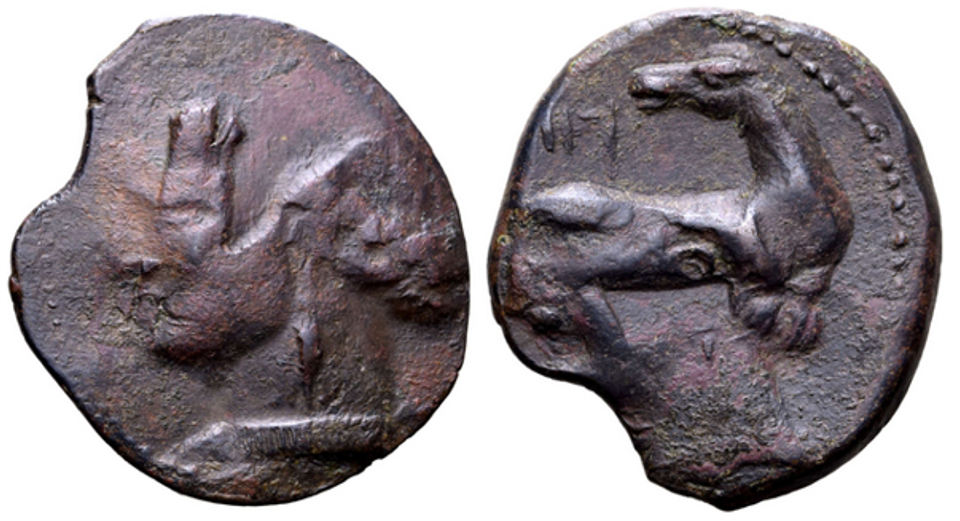3549 - Carthage (AE Tanit/horse) over Syracuse (Poseidon/trident) (CNG, EA 378, 13 July 2016, 80)
From SILVER
| Line 1: | Line 1: | ||
{{Overstrike | {{Overstrike | ||
| − | |Sale=Classical Numismatic Group, EA 378 | + | |Image overstriking coin=Carthage,_Roma_Numismatics_93,_6_Jan._2022,_60.png |
| + | |Image reference overstriking coin=https://pro.coinarchives.com/a/lotviewer.php?LotID=912528&AucID=1740&Lot=80 | ||
| + | |Image overstruck variety=Syracuse Poseidon trident.jpg | ||
| + | |Sale=Classical Numismatic Group, EA 378, 13 July 2016, 80 | ||
|Private collection=J.-P. Righetti collection | |Private collection=J.-P. Righetti collection | ||
|Obverse description=Head of Tanit left, wearing wreath. Border of dots. | |Obverse description=Head of Tanit left, wearing wreath. Border of dots. | ||
| − | |Reverse description=Horse right, head left. In field, uncertain Punic letter. | + | |Reverse description=Horse right, head left. In field, uncertain Punic letter. |
|Mint=Carthage | |Mint=Carthage | ||
|Ancient region=Zeugitana | |Ancient region=Zeugitana | ||
|Authority=Carthaginian Empire | |Authority=Carthaginian Empire | ||
| − | |Date from=215 | + | |Date from=215 BCE |
| − | |Date to=201 | + | |Date to=201 BCE |
| + | |Period=Hellenistic | ||
| + | |Metal=Bronze | ||
|Weight=5.99 | |Weight=5.99 | ||
|Diameter=19 | |Diameter=19 | ||
| − | |Axis=9 | + | |Axis=9 |
|Denomination=Shekel | |Denomination=Shekel | ||
| − | |Coin reference=B. Kapossy, | + | |Coin reference=B. Kapossy, Münzen der Antike : Katalog der Sammlung Jean-Pierre Righetti im Bernischen Historischen Museum, Bern, 1993, no. 21. |
|Coin series reference=SNG Copenhagen/Sylloge Nummorum Graecorum: The Royal Collection of coins and medals, Danish National Museum (43 vols), 1942-1979, no. 302-323 (Volume 8. Egypt, North Africa, Spain, Gaul).;J. Alexandropoulos, Les monnaies de l'Afrique antique. 400 av. J.-C.-40 ap. J.-C., Toulouse, 2007, no. 90 | |Coin series reference=SNG Copenhagen/Sylloge Nummorum Graecorum: The Royal Collection of coins and medals, Danish National Museum (43 vols), 1942-1979, no. 302-323 (Volume 8. Egypt, North Africa, Spain, Gaul).;J. Alexandropoulos, Les monnaies de l'Afrique antique. 400 av. J.-C.-40 ap. J.-C., Toulouse, 2007, no. 90 | ||
|Overstruck obverse description=Head of Poseidon right (visible on reverse). | |Overstruck obverse description=Head of Poseidon right (visible on reverse). | ||
| Line 21: | Line 26: | ||
|Overstruck ancient region=Magna Graecia (Sicily) | |Overstruck ancient region=Magna Graecia (Sicily) | ||
|Overstruck authority=Hieron II of Syracuse (tyrant of Syracuse, 270-215 BC) | |Overstruck authority=Hieron II of Syracuse (tyrant of Syracuse, 270-215 BC) | ||
| − | |Coin series reference overstruck=CNS II 198 | + | |Coin series reference overstruck=CNS II 198 |
}} | }} | ||
Revision as of 16:51, 17 April 2024
215 BCE - 201 BCE
Images
Overstriking coin

Carthage,_Roma_Numismatics_93,_6_Jan._2022,_60.png [1]
Location/history
| Sale(s)Sale(s) ᵖ: | Classical Numismatic Group, EA 378, 13 July 2016, 80 | |
| Private collection(s)Private collection(s) ᵖ: | J.-P. Righetti collection |
Overstriking coin
Description
| ObverseInscription or printing placed on the obverse.: | Head of Tanit left, wearing wreath. Border of dots. | ReverseInscription or printing placed on the reverse.: | Horse right, head left. In field, uncertain Punic letter. |
Mint and issuing power
| MintIdentifies the place of manufacture or issue of a numismatic object.: | Carthage | Ancient regionAncient region. | Zeugitana | Modern countryModern country: Tunisia | AuthorityIdentifies the issuing power. The authority can be "pretended" when the name or the portrait of X is on the coin but he/she was not the issuing power. It can also be "uncertain" when there is no mention of X on the coin but he/she was the issuing power according to the historical sources: | Carthaginian Empire |
Chronology
| FromIdentifies the initial date in a range assigned in a numismatic context. 215 BCE toIdentifies the final date in a range assigned in a numismatic context.. 201 BCE | Hellenistic 323-30 BC |
Physical description
| MetalThe physical material (usually metal) from which an object is made.: Bronze |
WeightWeight of the numismatic object (in grams). in grams: 5.995.99 g <br />5,990 mg <br /> | DenominationTerm indicating the value of a numismatic object. Examples: tetradrachm, chalkous, denarius.: Shekel | AxisDescribes the directional relationship between the obverse and reverse of a numismatic object.: 99 mm <br />0.9 cm <br /> |
| DiameterDescribes diameter of an object (in mm).: 1919 mm <br />1.9 cm <br /> | |||
References
| Coin referenceReference of the Coin: | B. Kapossy, Münzen der Antike : Katalog der Sammlung Jean-Pierre Righetti im Bernischen Historischen Museum, Bern, 1993, no. 21. | Coin series referenceReference to coin series study: | SNG Copenhagen/Sylloge Nummorum Graecorum: The Royal Collection of coins and medals1SNG Copenhagen/Sylloge Nummorum Graecorum: The Royal Collection of coins and medals, Danish National Museum (43 vols), 1942-1979, no. 302-323 (Volume 8. Egypt, North Africa, Spain, Gaul)., J. Alexandropoulos2J. Alexandropoulos, Les monnaies de l'Afrique antique. 400 av. J.-C.-40 ap. J.-C., Toulouse, 2007, no. 90 |
Overstruck type
Description
| ObverseInscription or printing placed on the obverse.: | Head of Poseidon right (visible on reverse). | ReverseInscription or printing placed on the reverse.: | ΣΥΡΑΚΟΣΙΩΝ Trident (visible on obverse: trident with part of Hieron’s name with the control letters Θ Φ below (control letters not listed in CNS). |
Mint and issuing power
| MintIdentifies the place of manufacture or issue of a numismatic object. ᵖ: | Syracuse | Ancient regionAncient region. ᵖ | Magna Graecia (Sicily) | Modern countryModern country: Italy | AuthorityIdentifies the authority in whose name (explicitly or implicitly) a numismatic object was issued. ᵖ: | Hieron II of Syracuse (tyrant of Syracuse, 270-215 BC) |
Chronology
| FromIdentifies the initial date in a range assigned in a numismatic context. toIdentifies the final date in a range assigned in a numismatic context.. | periodTime period of the numismatic object. |
Physical description
References
| Coin type referenceReference to coin series study ᵖ: | CNS II 1983CNS II 198 |
Additional data
| Frequency of overstrikesFrequency of overstrikes: | Level of confidenceLevel of confidence of the identification: | ||
| RemarksRemarks: | |||
